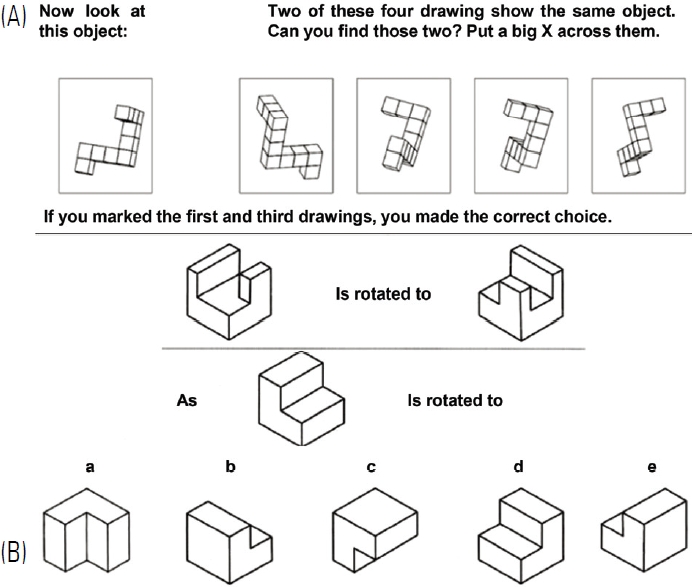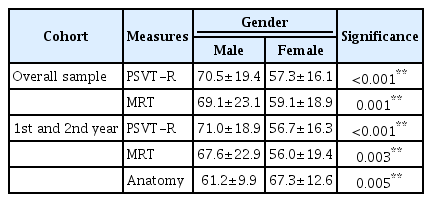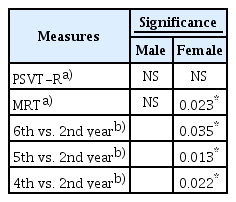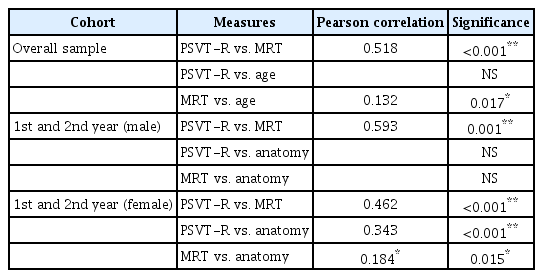Spatial ability and anatomy learning performance among dental students
Article information
Abstract
Purpose
Spatial perception is an essential skill for professional dentists. The objective of this study was to observe the spatial ability, as well as anatomy module grades, of dental students at a dental education center in Indonesia and relate these to gender and cohort.
Methods
A cross-sectional study was carried out where dental students in years (cohorts) 1, 2, 4–6 were invited to take the Revised Purdue Spatial Visualization Test (PSVT-R) and the redrawn Vandenberg and Kuse Mental Rotation Test (MRT) in order to assess spatial ability. In addition, the 1st- and 2nd-year dental students carried out gross anatomy assessments. Spatial ability test results were compared using an independent t-test to detect gender differences, one-way analysis of variance to inspect cohort differences, and correlation relative to anatomy module scores.
Results
A total of 326 dental students voluntarily participated. Statistically significant gender differences were found in both spatial ability tests in the overall sample (PSVT-R: p<0.001; MRT: p=0.001). When the 1st- and 2nd-year dental students were pooled, significant gender differences were detected, in which males scored higher than females in both spatial ability tests (PSVT-R: p<0.001; MRT: p=0.003). In anatomy, however, females scored higher than the males (p=0.005). In addition, there were weak to moderate, but significant correlations between spatial ability tests and anatomy scores.
Conclusion
This study indicated that spatial ability may not be the only factor predicting the academic performance of dental students. However, dental students with low spatial ability scores may need supplementary educational techniques when learning specific spatial tasks.
Introduction
Spatial ability is one influencing factor of skill acquisition in dentistry [1], although spatial ability and its relationship with competence and academic performance of dental students is still unanswered. Several studies have tested spatial ability among dental students in relation to diverse variables [1-10]. Hegarty et al. [7] in 2009 mentioned that the psychomotor-laboratory skills of dental students may be estimated by their level of spatial ability. On the other hand, successful dental education should increase spatial ability in students. Nilsson et al. [6] in 2007 suggested that it is important to consider different educational techniques during dental training to accommodate various levels of spatial ability.
The study of anatomy is fundamental in medical and dental education programs. Understanding clinically relevant problems requires comprehensive, three-dimensional (3D) anatomical concepts, in which spatial ability plays a pivotal role in mentally modeling these structures [7]. In addition, understanding medical images such as computed tomography, magnetic resonance imaging, cone beam computed tomography, X-rays, and ultrasound, as well as performing clinical procedures, also demand adequate spatial cognition [7,11,12]. Therefore, learning methods in anatomy curriculum must employ spatial ability improvement strategy [13]. Hence, many studies have explored spatial ability in relation to anatomical courses [13-19].
Spatial ability in dental undergraduate students in Indonesian higher institution settings has rarely been explored. This study aimed to assess spatial ability in Indonesian dental students and investigate the correlation between cohorts and gender. In addition, the relationship between spatial ability and anatomical course performance was explored. The null hypotheses of this study were that there are no differences in spatial ability test scores between gender and cohorts, and that there is no correlation between spatial ability and cohorts, between spatial ability and anatomy module grade, and between two spatial ability tests. The objectives of our study were to: (1) assess gender differences of spatial ability using the Revised Purdue Spatial Visualization Test (PSVT-R) and the Mental Rotation Test (MRT) tests; (2) assess correlation between two spatial ability tests; (3) assess spatial ability test score differences between cohorts; and (4) assess correlation between spatial ability and anatomy module grade.
Methods
The protocol of this study was ethically approved by the Research Ethics Committee Universitas Padjadjaran (736/UN6.KEP/EC/2020). Undergraduate dental students of the Faculty of Dentistry Universitas Padjadjaran (Indonesia) were invited to participate in the study. The students included preclinical dental students of the Bachelor of Dental Science program (1st–4th year) and the clinical dental students of the Professional Dentist degree program (5th–6th year). The third-year students did not participate for logistical reasons. The duration of the dental program is normally 6 years at this institution. Participants with incomplete spatial ability tests or anatomy scores were excluded. The design of the study was cross-sectional. Participation was entirely voluntary and the students could withdraw at any time. Three types of measures were utilized: two spatial ability test scores for all cohorts, and gross anatomy scores for the 1st- and 2nd-year dental students only.
1. Testing visual-spatial ability
The spatial ability of the dental students was assessed using the PSVT-R [20] and the redrawn Vandenberg and Kuse MRT [21]. The PSVT-R, which measures a student’s ability to visualize an unfamiliar 3D object from a different perspective to that shown in the test, consisted of 30 problems with one answer each (Fig. 1A). The MRT, where the subject must view a 3D object and determine which two of several alternatives shown to them displays the same object but rotated to a different position, consisted of 24 problems with two answers each (Fig. 1B). Both scores were transformed into percentages. The spatial ability tests were performed at the beginning of academic year 2020 during the coronavirus disease 2019 (COVID-19) pandemic. Therefore, the tests were taken online under supervision by utilizing Google Meet video conference calls (Google LLC, Mountain View, USA) and Qualtrics (September 2020; Qualtrics, Provo, USA).
2. Anatomical assessment scores
For the 1st- and 2nd-year dental students, the gross anatomy course scores were obtained in 2020 and 2019. The scores were the mean of theory and practical computer-based test (CBT) exams and quizzes in multiple choice as well as matching questions and images. The quizzes were taken several times during the term, while the exams were taken mid-term and end-term. The questions comprised pure anatomy and clinical anatomy types, using combinations of text only, pictorial, and anatomy model “spot” testing. The last was specifically employed only for the 2nd-year students prior to the pandemic. The gross anatomy course was part of a basic medical science (BMS) 1 block which comprises anatomy, physiology, and histology modules. The gross anatomy in BMS 1 focused on an introduction to anatomy, and then the musculoskeletal, respiratory, and nervous systems for dentistry. The duration of the study in BMS 1 anatomy is comprised of 16 hours of theoretical learning activities (lectures and tutorials) and 48 hours of practical activity in one semester. The exam and quiz problems for gross anatomy in BMS 1 are routinely renewed every year, so the CBTs were different for the 1st- and 2nd-year dental students. In addition, there was a difference in the exam and quizzes delivery mode between the two groups. The gross anatomy exam for the 2nd-year dental students was taken synchronously on campus, while the 1st-year assessments were carried out synchronously and fully online off campus during the pandemic.
3. Data analysis
All collected data were processed using IBM SPSS ver.25.0 for quantitative analysis (IBM Corp., Armonk, USA). An independent t-test was used to assess gender differences in spatial ability scores for both PSVT-R and MRT tests for the whole sample. Pearson’s correlation was then used to determine the relationship between PSVT-R scores or MRT scores and cohorts. Due to the much larger sample sizes, one-way analysis of variance (ANOVA) followed by least significant difference (LSD) post-hoc tests to detect whether there were statistically significant differences in spatial ability between cohorts were used in the female group only.
The second phase of the analysis involved only the 1st- and 2nd-year dental students. Gross anatomy course grades for these cohorts were obtained from university archives. To identify gender differences in the PSVT-R, MRT, or anatomy scores, independent t-tests were run with the two cohorts pooled. Pearson’s correlation was then used to assess the relationship between PSVT-R scores or MRT scores and the anatomy scores.
Results
In total, 326 (male=49, female=277; age, 17–24 years old) of the total number of 1,029 dental students (1st year=99; 2nd year=137; 3rd year=161; 4th year=159; 5th year=155; 6th year=178) were included in the study. No students withdrew after taking the spatial ability tests. The distribution of students across genders and cohorts are shown in Table 1.
The means and standard deviations of the PSVT-R, MRT, and anatomy scores were summarized based on cohort and gender (Table 1). For the overall sample, males had statistically significantly higher PSVT-R scores (70.5%±19.4%) compared to females (57.3%±16.1%, t [324]=5.139, p<0.001) (Table 2). Males also had statistically significantly higher MRT scores (69.1%±23.1%) compared to females (59.1±18.9%, t [324]=3.326, p<0.001).
Female students in the 1st-year cohort significantly outperformed male students in gross anatomy (p=0.034), while there were no significant differences detected for either spatial ability test in the 1st-year cohort. In the 2nd-year cohort, males scored significantly higher than females in the spatial ability tests (PSVT-R: p<0.001; MRT: p=0.019), while there were no significant differences in anatomy scores. When the 1st- and 2nd-year cohorts were pooled, males showed significantly higher spatial ability test scores than females in both tests, but in contrast, females presented significantly higher anatomy scores than males (Table 2).
There was a statistically significant difference in MRT scores among female cohorts as determined by one-way ANOVA (F [4, 272]=2.877, p=0.023) (Table 3). An LSD post-hoc test revealed that the PSVT-R scores of 6th-, 5th-, and 4th-year female cohorts were significantly higher than the 2nd-year female cohort. However, there was no significant difference found through one-way ANOVA among PSVT-R scores in male cohorts.
In the overall sample, in which all cohorts and genders were pooled, a significant and moderate positive correlation between PSVT-R and MRT scores was detected (r=0.518, p<0.001) (Table 4). Correlations between PSVT-R, MRT, and gross anatomy scores where the 1st- and 2nd-year dental students were pooled are also presented in Table 4. There were significant and moderate positive correlations between PSVT-R scores and MRT scores in the male (r=0.593, p=0.001) and female (r=0.462, p<0.001) groups. Furthermore, significant, but weak positive correlations between PSVT-R and gross anatomy (r=0.343, p<0.001), and MRT and gross anatomy scores (r=0.184, p=0.015) were found.
Discussion
Although spatial ability among undergraduate students has been explored well in the published literature, it remains obscure in an Indonesian setting, especially in dental education, where these skills are particularly important. This is the first study to investigate spatial ability among Indonesian undergraduate dental students and to relate it to their gross anatomy course performance.
Undergraduate dentistry in the Faculty of Dentistry Universitas Padjadjaran (Indonesia) comprises two stages. In the first stage of study, students complete the Bachelor of Dental Science study program over a period of eight semesters, covering BMS, basic dental science, skills laboratory activities, treatment planning, and research study. The student-centered learning curriculum utilizes active learning methodologies, where students learn basic psychomotor skills in simulation, hybrid problem-based learning, case-based, and blended learning activities, as well as traditional lectures and clinical experiences. After completing the Bachelor of Dental Surgery Program, the students continue to the Dental Professional Study Program, consisting of four semesters of the clinical stage. By completing this second phase of education, students obtain the Doctor of Dental Surgery degree. In this study, students from all 6 years except 3rd year were investigated.
The gross and dental anatomy curriculum in the Faculty of Dentistry Universitas Padjadjaran (Indonesia) is distributed across the first quarter of the 6-year course. In the first semester, BMS 1 covers introduction to gross anatomy, and then the musculoskeletal, respiratory, and nervous systems for dentistry. During the second semester, BMS 2 gross anatomy covers the gastrointestinal, cardiovascular, and lymphatic systems for dentistry; BMS 3 gross anatomy covers neck structures, eyes and ears; Basic Dental Science (BDS) 1 consists of embryology of the craniofacial structures; and finally, BDS 2 contains dental anatomy and morphology. In the third semester, BDS 4, which discusses mastication muscles, completes the gross anatomy curriculum. Therefore, only the 1st- and 2nd-year cohorts were used in the present study.
There were some differences in the study method in the present study compared to previous studies investigating spatial ability due to the COVID-19 pandemic, which has changed the education field worldwide. Higher education closures, including dental education institutions and abrupt transformation to online learning, have raised concerns regarding the survival of dental education, especially in the clinical phase. Unlike other undergraduate health professional study programs, dentistry relies heavily on manual dexterity as part of the competencies of a practitioner. During the pandemic, the preclinical or Bachelor of Dental Science program in Universitas Padjadjaran was presented online, in both synchronous and asynchronous mode, using the institution’s Learning Management System on a combination of virtual meeting platforms. This resulted in differences in learning methods of modules between the 1st- and 2nd-year dental students in this study. With permission from the PSVT-R and redrawn Vandenberg and Kuse MRT creators, this study converted the paper-based tests used in previous studies into online CBTs [20-22].
Previous studies discussing spatial abilities with relevance to anatomical knowledge employed various types of spatial ability tests, ranging from PSVT-R, MRT, Novel Object Cross-Section, and Guay’s Visualization of Views Test [7,15,16,23-27], with MRT the most utilized tool [19]. The methods of choice in this study were PSVT-R and MRT, because different spatial ability tests may utilize different strategies or techniques.
The majority of dental students in the Faculty of Dentistry Universitas Padjadjaran (Indonesia) were female, which was reflected in the participant composition (85.29%). This number was comparable with other dental education providers in Indonesia [28].
Previous studies have employed gender difference study design in both or either of spatial ability and anatomy scores [21,22,29]. One of the aims of the present research was to examine the gender differences in spatial ability tests using MRT and PSVT-R in order to propose the appropriate choice of anatomy learning methods and types of assessment in order to reduce the existed gaps. The present study revealed that male students scored more highly in both spatial ability tests than females when the overall sample was pooled (Table 2), which corroborated the results of previous studies [21,22,29]. Due to the imbalance in gender number and lower sample sizes in each cohort, gender differences in each year were not investigated. In 2021, Roach et al. [13] performed a meta-analysis of 1,292 participants and found significantly higher MRT in males compared to females but no gender difference was detected for anatomy performance scores. The findings by Roach et al. [13] were corroborated by this study in which PSVT-R and MRT scores favored males than females, but at the same time differed when this study exhibited that females surpassed males significantly in anatomy scores. This variation may be due to the imbalance sample size between two gender groups in this study. The gender differences in anatomy scores and spatial ability should be considered when determining the balance of spatial and non-spatial assessment in anatomy curriculum.
For the two cohorts studying anatomy, females scored higher in their anatomy tests, which may indicate that spatial ability is not the only factor affecting academic performance. This finding supports the result of a meta-analysis by Roach et al. [13] in 2021 and a previous study by Peters et al. [22] in 1995 who both found significant gender differences in spatial ability tests were not accompanied by gender differences in academic performances. The fact that female 2nd-year dental students presented significantly lower scores on the MRT than 6th-, 5th-, and 4th-year students is possibly a stronger indication of the role of progressing dental education (Table 3).
The anatomy tests in the Faculty of Dentistry Universitas Padjadjaran involves multiple-choice question and matching questions, combining text only problems and pictorial problems. Although 3D anatomy tests require spatial ability, this study, which employed two-dimensional (2D) anatomy problems, considered that spatial ability plays some role in terms of mentally rotating pieces of 2D anatomical pictures as a whole 3D structure. Significant, though weak positive correlations were found between anatomy grades and both PSVT-R and MRT score in the female group (Table 4). This may indicate a relationship between anatomy and spatial ability, but further research is necessary. Correlation was not found between any of the spatial ability tests and anatomy scores in the male group. This finding was in agreement with the previous study by Hegarty et al. [7] in 2009, which showed that anatomy class grades did not correlate with any of the spatial ability tests.
Previous studies by Lufler et al. [15] in 2012 and Vorstenbosch et al. [16] in 2013 demonstrated that students’ visual-spatial ability was improved by gross anatomy course participation and vice versa but this study was unable to support nor refute this statement due to the differences in study design.
Ranney et al. [30] in 2005 mentioned that spatial ability tests were utilized in the dental student selection process in North American countries. In order to determine whether visual-spatial ability tests should be used in dental study program applications, a robust study design should be established. The correlation between anatomy and spatial ability scores in females in the current study may indicate that students with low visual-spatial ability might have difficulties in a gross anatomy course, although the correlations were weak. Therefore, introducing an anatomy module involving 3D mental rotation of anatomical structures, as with the Tooth Cross-Section test used by Hegarty et al. [7] in 2009, or learning with 2D anatomical pictures and 3D anatomical models as suggested by Sezer et al. [31] in 2021 may potentially improve the spatial ability of dental students.
This study only involved dental students in which the cohort of the subjects exposed to Universitas Padjadjaran as the source higher education institution in this study currently offers a wide range of healthcare education which include anatomy in their curricula such as dental, medical, psychology, nursing, midwifery, and pharmacy. Previous studies found significant differences among healthcare faculties which may be due to the different anatomy curriculum such as the study duration and depth [31-33]. Therefore, future studies should be performed across healthcare faculties which incorporate anatomy in their curricula simultaneously to inform the choice of learning strategies.
The current study has certain limitations. Participation rate (32.4%) was lower than the overall number of students in the targeted group. Although participation was encouraged, it was voluntary. In addition, tests being carried out online was a confounding factor, but unavoidable due to the pandemic. There was also an imbalance of gender sample sizes, although this reflects the gender ratio of dental students in Indonesia.
This study strongly suggests that future research of spatial ability longitudinally, following a cohort of dental students through the study program, might be useful in evaluating the impact of the dental curriculum on the development of spatial ability. Shifting the data collection (spatial ability tests) to an on campus, either paper based or CBTs, would also provide better control over the test environment.
Several studies were conducted in the field of spatial ability and its relation with anatomy curriculum. However, the settings were varied, such as: the spatial ability testing instruments; the subjects background (level of studies and healthcare majors); type of learning activities, depths, duration, and assessments; technology used in the learning process; also, the level of experience of the anatomy teachers; learner types. Despite the limitations, this study may serve as a preliminary for more robust future research which potentially beneficial of the development of dental curriculum specifically in countries with limited resource settings.
In conclusion, gender differences existed in spatial ability but that the reverse was true in terms of anatomy scores. This is in indication of other factors influencing academic performance at play. This study also found that female students further along their dental curriculum scored more highly in spatial ability scores than lower cohorts, which may indicate an effect of dental education on spatial ability. Longitudinal study of spatial ability among dental students to observe the progressing effect of dental curriculum is warranted. More studies are necessary to evaluate learning techniques and assessment used in dental education to refine spatial ability for overall students but simultaneously support students with low spatial ability, which is required to build dental competencies.
Acknowledgements
We would like to convey our gratitude to Dr. S.Y. Yoon for granting permission to use the Revised Purdue Spatial Visualization Test (PSVT-R) and to Dr. Michael Peters for granting permission to use the redrawn Vandenberg and Kuse Mental Rotation Test (MRT). In addition, we would like to extend gratitude to all the participants in this study.
Notes
Funding: No financial support was received for this study.
Conflicts of interest: No potential conflict of interest relevant to this article was reported.
Author contributions: Conceptualization: E. Sarilita, YAL, DFR, TW; methodology: E. Sarilita, YAL, DFR, TW; formal analysis: E. Sarilita, YAL, TW; validation: E. Sarilita, YAL; writing–original draft preparation: E. Sarilita; writing–review and editing: E. Sarilita, YAL, DFR, TW, SS, RS, DA, E. Sjamsudin; and approval of final manuscript: all authors.





